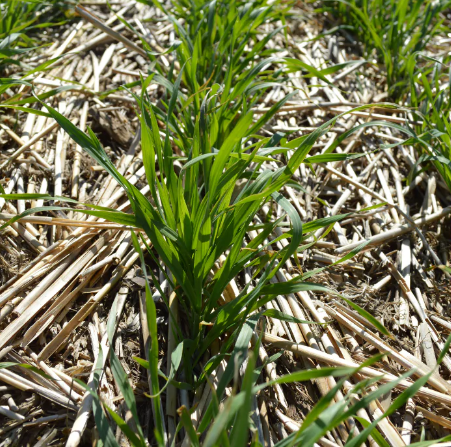
This time of year is always busy and exciting for our team at Green Cover as folks are ordering the covers they’ll plant after harvest. When it comes to fall-planted cover crops, the first species that comes to mind is often cereal rye because of its versatility, reliability and cost effectiveness. But what about the other winter cereals, what are the options and what are some examples of scenarios in which other winter cereals may be worth considering over a cereal rye?
Winter cereal rye remains the undisputed king of cover crops due to its extreme cold tolerance and wide planting window. Cereal rye has the ability to germinate in soils as cold as 34 degrees and even photosynthesize at 38 degrees when the sun is shining. This is a huge soil health advantage to have a living, growing plant when most other winter cereals have gone dormant and brown. It can be planted very late in the season and still successfully vernalize. It is the first crop to break dormancy in the spring so it is the best weed control of anything you can plant in the fall. We like the Elbon variety for its shorter winter dormancy period (best for early forage or roller-crimp termination) and its smaller seed size which reduces your seeding rate and can help offset the higher cost of seed. Hazlet is a more traditional “northern” variety of cereal rye and is exceptionally winter hardy – even when planted late. Slightly longer maturity than Elbon, it often works better when being grown as a companion with hairy vetch as the maturity times match up well. CoverMax F2 Hybrid rye works well for an earlier fall plantings (during optimal wheat planting time-frames) as it tillers very well in both fall and spring.
Rye is a great fall planted cover crop but because it takes off and starts growing super fast in the spring, it must be managed properly in the spring. Termination timing according to your goals and context is the key to managing moisture and nutrient cycling.
Winter triticale is a cross between cereal rye and wheat. It has the cold hardiness and biomass-producing traits from the rye while having better forage qualities from the wheat parent. Triticale is the best winter cereal if maximizing spring forage is a priority – it can be chopped, baled or grazed very successfully all the way through the early head stage. It is a little longer season than cereal rye so consider following it with another forage crop, milo, corn silage, or a short season grain corn. With forage shortage across the country, triticale seed supplies are moving fast so contact us soon and let us help you grow some forage!
If you’re in wheat country and growing rye is a problem, winter wheat can be used in place of rye. Wheat does have a higher protein value for grazing and after it heads out it maintains its forage quality. Wheat has considerably lower amounts of above and below ground biomass production compared to rye or triticale. Wheat is also less active during winter than rye.
Winter Barley is not as winter hardy as winter wheat, triticale or rye but it does grow especially well in soils with high pH or high salinity. It is not as fast-growing or aggressive as rye, which makes it somewhat less effective for spring weed control, but this also makes it a better cereal ahead of corn as there are less nitrogen tie up effects. Barley will produce a lower quantity of forage compared to rye or triticale but it is of higher quality. Our beardless Valor variety makes for excellent fall and spring grazing. If you can get barley to overwinter, it is fast to mature and will be ready to harvest before cereal rye.
Winter Black Oats are one of the most palatable winter cereals that you can plant. We have an excellent supply of the Cosaque black oats this year and while not as winter hardy as the previously mentioned cereals, they will survive single digits and even subzero temps with some snow cover. Even if they do not survive the winter in more northern climates, they are a far better fall-planted option than spring oats which will winterkill in the low 20’s most years. Winter oats are one of the best forage cereals for the south (Zone 6A or higher) and they will pair very well with winter peas or vetch for outstanding spring forage options.
While each of these species has specific characteristics to consider, it’s worth noting that a diverse mix of these cereals can leverage the benefits of each species. For spring calving pasture, for example, mixing a lot of these cereals can create a sort of relay race effect where each species matures at a different time, so cattle can select for the highest quality forage at the time.
Remember that as we move into the fall, we have fewer choices to select from, but we still have good options to get the ground covered for erosion prevention, improved infiltration, compaction breaking and supplemental winter and spring grazing. Give us a call at (402) 469-6784 or shoot us an email at info@greencoverseed.com and let us help keep you covered!
Want to talk with one of our expert sales representatives?
Fill out this form or give us a call today. 402-469-6784.